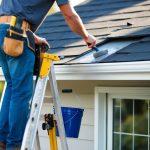DIY Roof Repair: Safeguarding Your Home with Essential Tips and Tools
Enhancing Roof Longevity
Extending the lifespan of a roof requires making informed decisions about materials and employing diligent maintenance practices. Selecting robust roofing materials and adopting advanced maintenance techniques can help preserve a roof’s integrity and protect a home from weather elements.
Selecting Durable Roofing Materials
Choosing the right materials is crucial for a long-lasting roof. Asphalt shingles, being cost-effective and durable, remain popular. Available in various styles, they offer resistance against diverse weather conditions. Metal roofing, known for its longevity, can last over 50 years with adequate care and is highly resistant to wind and fire. Clay and concrete tiles bring durability and aesthetic value, although they require proper structural support due to their weight.
Slate roofing offers unmatched durability, often lasting a century. It provides a natural appearance but demands a substantial initial investment and a reinforced roof structure to support its weight. These materials vary in cost, weight, and maintenance requirements, but understanding these factors can aid in decision-making to enhance roof durability and protect structural integrity.
Implementing Advanced Maintenance Techniques
Regular and advanced maintenance ensures a roof remains in optimal condition. Annual inspections help identify potential issues, such as missing shingles or leaks. Cleaning gutters and downspouts prevents water backup, which can damage a roof’s edge. Removing debris like leaves and branches reduces the risk of moisture retention and mold growth.
Addressing minor repairs promptly can prevent the escalation of issues, saving time and cost in the long run. Using protective sealants enhances resistance to weather elements, while trimming overhanging branches minimizes damage risk. Incorporating these maintenance practices can significantly promote longevity, safeguarding against structural damage and maintaining roof performance over time.
Environmental Considerations
Environmental considerations play a crucial role in roof repair and selection. Choosing eco-friendly materials and assessing the impact of local weather conditions can enhance sustainability and durability.
Eco-Friendly Roofing Options
Eco-friendly roofing options are essential in reducing environmental impact. Materials such as metal, recycled shingles, and clay tiles sustainably provide a durable covering. Metal roofs, for instance, are energy-efficient and recyclable, which minimizes waste. Recycled shingles composed of rubber, plastic, or wood fiber offer an alternative that utilizes previously discarded materials, reducing landfill contributions.
Clay tiles are another sustainable choice, being long-lasting and naturally derived. Their reflective properties help improve energy efficiency by maintaining indoor temperatures. Implementing green roofs covered with vegetation can further enhance insulation while promoting biodiversity. Understanding these eco-friendly choices can significantly contribute to a home’s sustainability without compromising on protection or performance.
Impact of Weather and Climate on Roofing
Weather and climate significantly affect roofing performance and lifespan. Areas experiencing heavy rain require materials resistant to water damage, such as asphalt shingles or slate tiles. These materials prevent leaks and structural compromise. Coastal regions, prone to salt-laden air and storms, benefit from corrosion-resistant metal roofing.
High temperatures make materials like tile and metal preferable due to their heat-reflective properties. Cold climates necessitate the use of durable materials like slate or certain composite shingles designed to withstand freezing conditions. Climate considerations must guide material choice and maintenance strategies to extend the life of any roofing solution. Assessing local climate can lead to significant cost savings and improved longevity over time.



